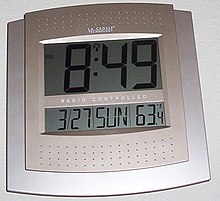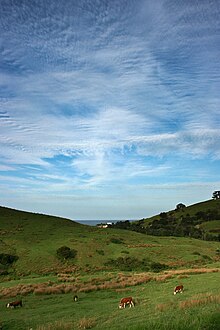"NZT" redirects here. For other uses, see NZT (disambiguation).
| Time zone | Standard time | Daylight time |
|---|---|---|
| New Zealand | UTC+12:00 | UTC+13:00 |
| Chatham Islands | UTC+12:45 | UTC+13:45 |
Time in New Zealand is divided by law into two standard time zones. The main islands use New Zealand Standard Time (NZST), 12 hours in advance of Coordinated Universal Time (UTC) / military M (Mike), while the outlying Chatham Islands use Chatham Standard Time (CHAST), 12 hours 45 minutes in advance of UTC / military M^ (Mike-Three).
During summer months – from the last Sunday in September until the first Sunday in April – daylight saving time is observed and clocks are advanced one hour. New Zealand Daylight Time (NZDT) is 13 hours ahead of UTC, and Chatham Daylight Time (CHADT) 13 hours 45 minutes ahead.
New Zealand's associated states – the Cook Islands and Niue – and the dependent territory of Tokelau use several different time zones at their own discretion.
History
On 2 November 1868, New Zealand officially adopted a standard time to be observed nationally, and was the first country to do so, about fifteen years before any other. Chatham Island was 45 minutes ahead of mainland New Zealand . It was based on longitude 172° 30′ East of Greenwich, 11+1⁄2 hours ahead of Greenwich Mean Time (GMT). This standard was known as New Zealand Mean Time (NZMT).
In 1941, during the Second World War, clocks were advanced half an hour, to reduce electric power use making New Zealand 12 hours ahead of GMT. This change was made permanent from 1946 by the Standard Time Act 1945, at which the time at the 180°E meridian was made the basis for New Zealand Time. NZST remained half an hour ahead of NZMT, and the Chatham Islands 45 minutes ahead of NZST.

In the late 1940s the atomic clock was developed and several laboratories began atomic time scales. A new time scale known as Coordinated Universal Time (UTC) was adopted internationally in 1972. This was based on the readings of atomic clocks, updated periodically in accordance with time variations in the Earth's rotation by the addition or deletion of seconds (called leap seconds). The Time Act 1974 defines New Zealand Standard Time as 12 hours in advance of UTC.
In 2011, the New Zealand dependency of Tokelau moved its time zone forward by 24 hours, by skipping 30 December to be in the UTC+13:00 time zone, the same zone as New Zealand daylight saving.
Daylight saving time (DST)
Starting in 1909, a member of Parliament, Sir Thomas Kay Sidey annually put forward a bill to advance the clocks an hour from September to the following March and the Summer Time Act 1927 succeeded. In 1927, clocks were advanced by an hour from first Sunday in November to the first Sunday in March. This proved unpopular, so the Summer Time Act 1928 revised this to a half-hour shift from 14 October 1928 (second Sunday) to 17 March 1929 (third Sunday), then the Summer Time Act 1929 permanently fixed this half-hour shift to run from the second Sunday in October to the third Sunday in March every year. In 1933, the period was extended from the first Sunday in September to the last Sunday in April. This continued until the Second World War, when emergency regulations in 1941 extended daylight saving to cover the whole year with annual re-applications until the Standard Time Act 1945 made the abandonment of NZMT permanent in 1946, so that 180° becomes the base longitude and what was called NZ Summer Time (NZST) became NZ Standard Time.
The Time Act 1974 empowered the governor-general to declare by Order in Council a period when daylight saving time is to be observed. This was a one-hour shift (on top of the earlier half-hour shift) from the first Sunday in November to the last Sunday in February, promptly changed the next year by The New Zealand Time Order 1975 which fixed the period of observance from the last Sunday in October to the first Sunday in March.
In 1985 a comprehensive survey was undertaken by the Department of Internal Affairs. Public attitudes towards NZDT (New Zealand Daylight Time) and its effects on work, recreation and particular groups of people in society were surveyed. The survey indicated that 76.2% of the population wanted NZDT either continued or extended.

The survey also concluded that opinion on the topic differed little between sexes, and that support for NZDT was generally higher in urban centres. Daylight saving was famously opposed in the small Northland dairy farming community of Ararua, which refused to adjust its clocks for some years. Support for shortening or abolishing NZDT was always in the minority in the areas surveyed.
As a consequence of the survey and further feedback from the public, in 1988 the Minister of Internal Affairs arranged for a trial period of extended NZDT to be held from the second Sunday in October 1989 to the third Sunday in March 1990. The Minister invited the public to write to him with their views on the five-week extension.
The Daylight Time Order 1990 declared that NZDT would run from 02:00 NZST on the first Sunday in October to 03:00 NZDT on the third Sunday in March.
On 30 April 2007 the government announced that it had extended the daylight saving period from 24 to 27 weeks. From September 2007, daylight saving is now observed from the last Sunday in September until the first Sunday in April. From 30 April 2007, DST begins at 02:00 NZST on the last Sunday in September each year, and ends at 03:00 NZDT (or 02:00 NZST as defined in the 1974 Act) on the first Sunday in April.
New Zealand time, including DST, is used by several Antarctic bases that are supplied from New Zealand. This results in the oddity that the Amundsen–Scott South Pole Station sets its clocks an hour further ahead during the southern summer, when the sun is constantly above the horizon, than in the southern winter, when the sun is constantly below the horizon. The extreme geographic position of the base means that no possible adjustment of the daily activity cycle can have any effect on the amount of sunlight received during those activities. However, the arrangement presumably makes real time communications with New Zealand more practical, particularly in dealing with offices.
The other countries in the Realm of New Zealand – Cook Islands, Niue, and Tokelau – do not maintain DST. Two of them are on the other side of the International Date Line and have 22–24 hours time difference to New Zealand.
The following table lists recent and near future starting and ending dates of daylight saving time in the main islands of New Zealand:
| Year | End | Start |
|---|---|---|
| 2022 | 3 April | 25 September |
| 2023 | 2 April | 24 September |
| 2024 | 7 April | 29 September |
| 2025 | 6 April | 28 September |
| 2026 | 5 April | 27 September |
| 2027 | 4 April | 26 September |
Standards
New Zealand standard time is maintained by the Measurement Standards Laboratory (MSL), part of New Zealand Government. New Zealand standard time is based on Coordinated Universal Time (UTC). UTC is kept within 200 nanoseconds of the international atomic time scale maintained by the International Bureau of Weights and Measures in Paris.
It is disseminated by various means, including time pips broadcast on Radio New Zealand, speaking clock and Network Time Protocol.
Dependencies and associated states
| Time zone | Standard time | Daylight time |
|---|---|---|
| Tokelau | UTC+13:00 | |
| Cook Islands | UTC−10:00 | |
| Niue | UTC−11:00 | |
| Ross Dependency | UTC+12:00 | UTC+13:00 |
There are two associated states of New Zealand in the Pacific Ocean, both on the other side of the International Date Line:
- The Cook Islands are in the UTC−10:00 time zone or Military W (Whiskey) and do not observe daylight saving time. Clocks in the Cook Islands are 22 or 23 hours behind New Zealand: at noon on Thursday in New Zealand, it is 13:00 or 14:00 on Wednesday in the Cook Islands.
- Niue is in the UTC−11:00 time zone or Military X (X-ray) and does not observe daylight saving time. Clocks in Niue are 23 or 24 hours behind New Zealand: at noon on Thursday in New Zealand, it is noon or 1 pm on Wednesday in Niue.
The New Zealand dependency of Tokelau is in the UTC+13:00 time zone or Military M' (Mike Prime) and does not observe daylight saving time. Clocks in Tokelau are set to the same time as or 1 hour ahead of New Zealand: at noon on Thursday in New Zealand, it is 12:00 or 13:00 on Thursday in Tokelau.
The Ross Dependency, McMurdo Station and Amundsen–Scott South Pole Station in Antarctica maintain NZST/NZDT.
References
- ^ "Military time zone chart of the World". worldtimezone.com. Retrieved 22 June 2018.
- "Time Act 1974". New Zealand Legislation. 30 March 1987. Retrieved 29 July 2017.
- "New Zealand Daylight Time Order 2007 (SR 2007/185) (as at 06 July 2007) – New Zealand Legislation". legislation.govt.nz. Retrieved 4 May 2017.
- Biswell, Shelly Farr; Nester, Richard (November–December 2007). "Time". New Zealand Geographic. 88.
- King, Thomas (1902). "On New Zealand Mean Time, and on the Longitude of the Colonial Observatory, Wellington; with a Note on the Universal Time Question". Transactions and Proceedings of the Royal Society of New Zealand. 35: 428–451.
- "Evening Post — 8 April 1929 — OUR TIME". paperspast.natlib.govt.nz. 2011. Archived from the original on 19 September 2018. Retrieved 24 October 2011.
- Transactions and Proceedings of the New Zealand Institute (1868). Vol. 1. May 1869. p. 48.
- "Daylight Saving Extension Proposal - Saving electric power". Gisborne Herald. Vol. LXVIII, no. 20502. 12 March 1941. p. 11.
- ^ "Daylight Saving History". dia.govt.nz. The Department of Internal Affairs. Retrieved 4 May 2017.
- "Standard Time Act 1945 (9 GEO VI 1945 No 15)". nzlii.org. Retrieved 4 May 2017.
- ^ "COORDINATED UNIVERSAL TIME (UTC) (CCTF/09-32)" (PDF). Bureau International des Poids et Mesures. p. 3. Retrieved 5 October 2022.
- ^ "Time Act 1974 No 39 (as at 30 March 1987), Public Act Contents – New Zealand Legislation". legislation.govt.nz. Retrieved 4 May 2017.
- "Tokelau to follow Samoa on dateline switch". Radio New Zealand International. 29 September 2011. Archived from the original on 3 March 2012. Retrieved 22 November 2011.
- Olssen, Erik (1996). "Sidey, Thomas Kay". Dictionary of New Zealand Biography. Retrieved 5 May 2020.
- ^ Pearce, Chris (6 April 2017). The Great Daylight Saving Time Controversy. Australian eBook Publisher. ISBN 9781925516968. Retrieved 4 May 2017.
- ^ "Ararua time". Te Ara: The Encyclopedia of New Zealand. Retrieved 6 February 2010.
- "Daylight Saving". The Department of Internal Affairs. 3 April 2023.
- "Radio New Zealand's pips are being fixed". Radio New Zealand. 1 October 2013. Retrieved 4 May 2017.
- "Time and Frequency Standards Services". Measurement Standards Laboratory of New Zealand. MSL. Retrieved 8 December 2017.
- Tokelau in wrong time zone?, Time zone database.
- "Time Zones in Antarctica". Retrieved 4 May 2017.
External links
- Measurement Standards Laboratory
- "Time Zones of New Zealand". Statoids.
- Daylight Saving page from The Department of Internal Affairs.
- Timekeeping in Te Ara – the Encyclopedia of New Zealand
| New Zealand articles | |||||||||
|---|---|---|---|---|---|---|---|---|---|
| History | |||||||||
| Geography |
| ||||||||
| Politics |
| ||||||||
| Economy | |||||||||
| Society |
| ||||||||
| Time in Oceania | |
|---|---|
| Sovereign states | |
| Associated states of New Zealand | |
| Dependencies and other territories | |